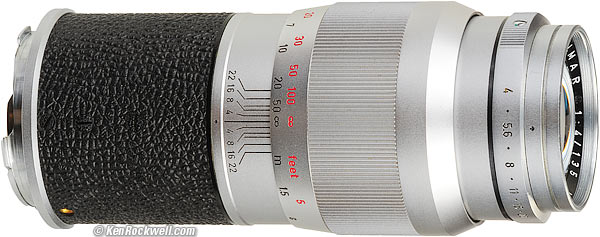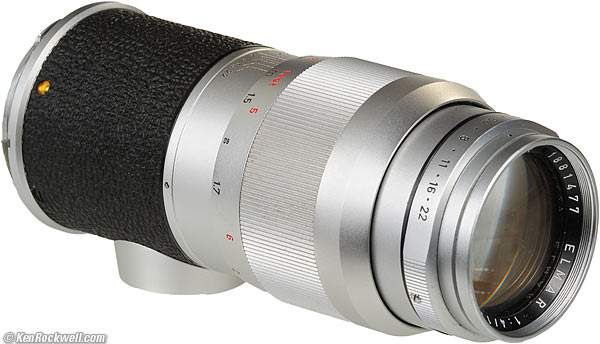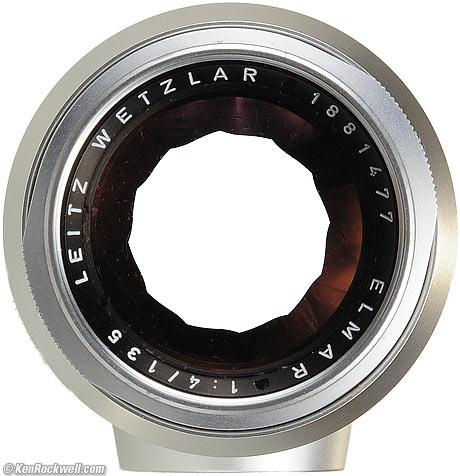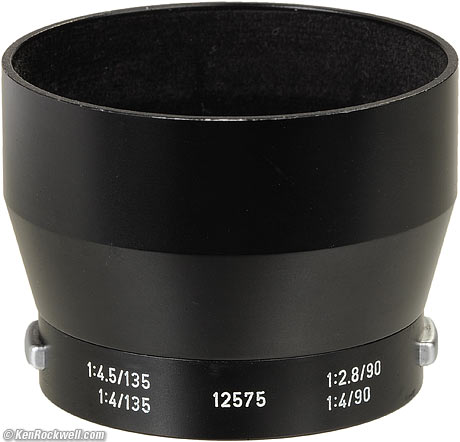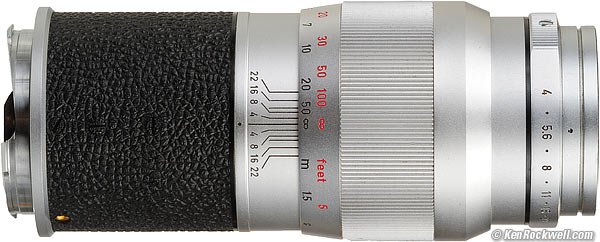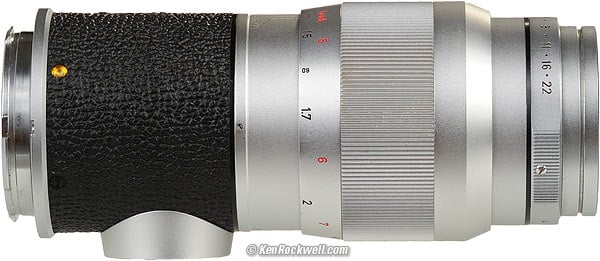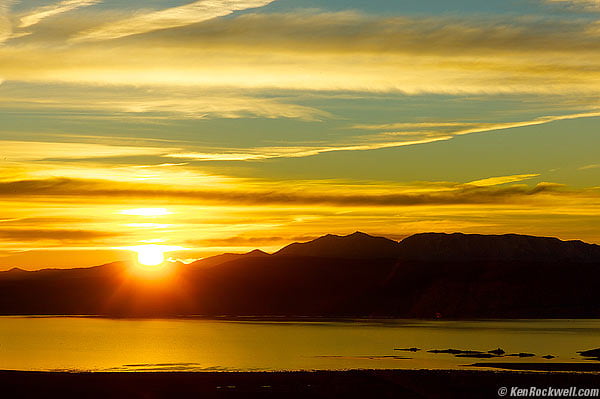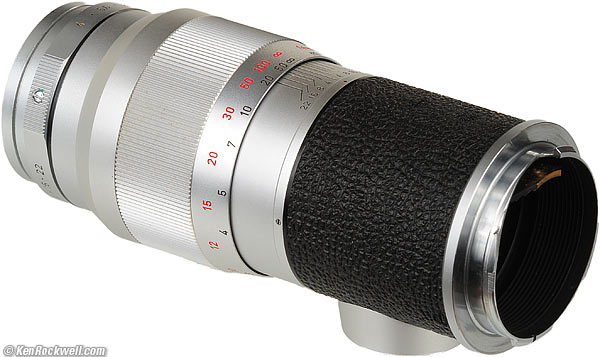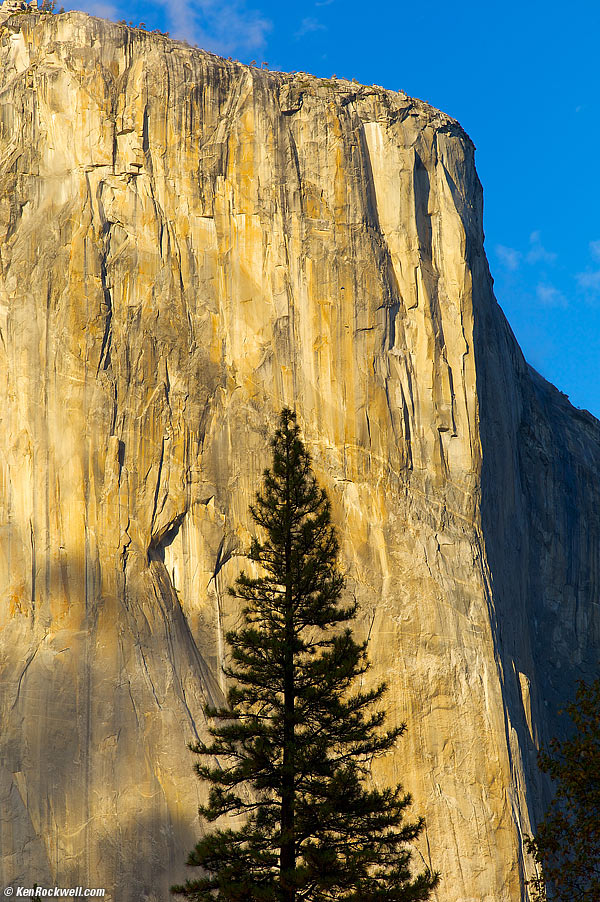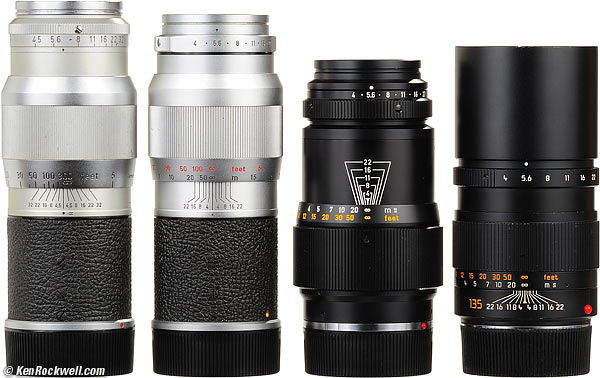Home Donate New Search Gallery Reviews How-To Books Links Workshops About Contact
LEICA 135mm f/4
LEITZ WETZLAR ELMAR
(1960-1965)
© 2011 KenRockwell.com. This page best with Corporate S regular and bold activated.
Intro Specs Performance Compared Recommendations
LEICA ELMAR 135mm f/4 (39mm filters, 14.3 oz./405g, about $200 used). Vergrößern. This free website's biggest source of support is when you use these links, especially this link to them at eBay (see How to Win at eBay). It helps me keep adding reviews of this ancient stuff when you get yours through these links, regardless of the country in which you live. Thanks! Ken.
April 2011 LEICA Reviews LEICA Lenses lesser-brand reviews
Sample image (more from Yosemite in Winter.)
Introduction top
Intro Specs Performance Compared Recommendations
Introduced at Photokina in 1960, the LEICA ELMAR 135mm f/4 is an extraordinary lens today, as well as an extraordinary bargain.
The 135mm f/4 has super-sharp optics at every aperture, a magnificent 12-bladed diaphragm, no distortion, no falloff, impeccable mechanical quality, and sells for only about $200 used.
It works fantastically as an ultra-telephoto on all LEICA M cameras, especially its contemporary the LEICA M3, as well as today's newest LEICA M9.
It is LEICA's lightest 135mm lens ever, takes standard 39mm filters and the same snap-on A42 12 575 hood as the LEICA ELMARIT 90mm f/2.8, and therefore my very favorite 135mm lens.
LEICA's catalogs of the 1960's said "this is one of the sharpest lenses ever created," and it is. It's ultra-sharp even at f/4.
Not bad for $200.
Compatibility top
This LEICA ELMAR 135mm f/4 works perfectly on every LEICA M camera, from the LEICA M3 of 1954 through today's LEICA M7, LEICA MP and LEICA M9.
It also came in a version for screw-mount cameras like the LEICA IIIf.
LEICA ELMAR 135mm f/4. Vergrößern.
Specifications top
Intro Specs Performance Recommendations
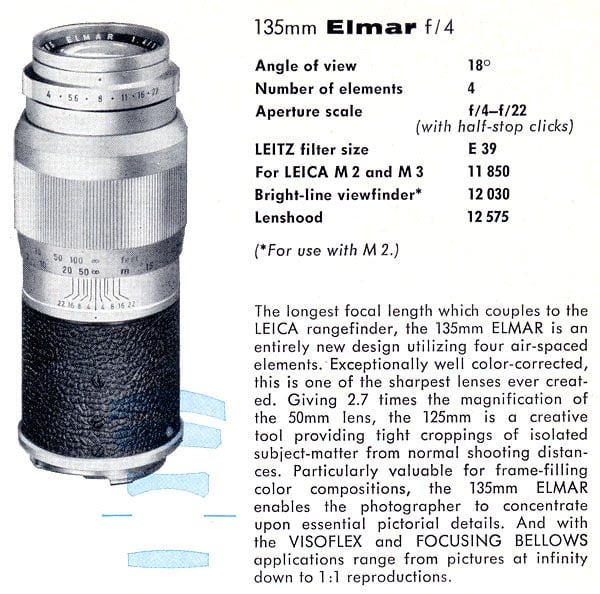
Catalog entry, 1964: "one of the sharpest lenses ever created."
Name
Leica calls this the LEICA 135mm ELMAR f/4.
Optics top
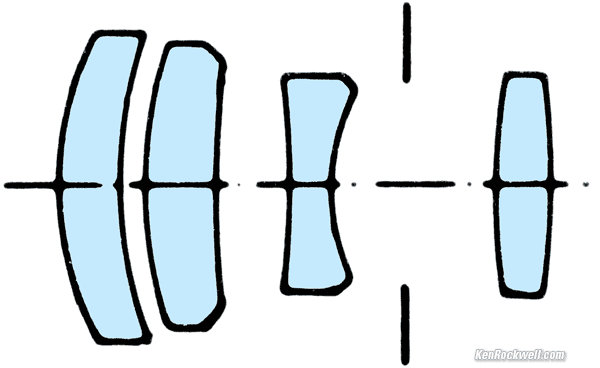
LEICA ELMAR 135mm f/4 diagram.
4 elements in 4 groups.
Rare-earth Lanthanum glass.
Single-coated in amber and magenta.
Diaphragm top
LEICA ELMAR 135mm f/4, at f/5.6. Vergrößern.
12 blades.
It stops down to f/22 with half-stop clicks.
Close Focus
1.5 meters or 5 feet, marked.
Filters
Standard 39 x 0.5 mm.
Size top
53.04 mm (2.088") maximum diameter by 122.69mm (4.830") extension from flange.
129.25mm (5.089") overall.
Weight top
14.280 oz. (404.85g).
15.115 oz. (428.5g) with metal front cap and 14 269 rear cap.
Caps top
The front cap is any of the standard chromed-brass, Hungarian yak-felt lined press-on A42 caps. A crappy little 39mm snap-in will work, but is disrespectful.
The rear cap is the standard 14 269 M rear cap today.
Hood top
LEICA 12 575 hood. Vergrößern.
The hood snaps-on to the standard A42 front mount.
An older version was marked for 9 cm and 13.5 cm lenses and has a chrome ring. They all do the same thing.
The 135mm lenses use the same hoods as the E39 LEICA ELMARIT 90mm f/2.8 lenses.
I use an Oriental 55mm plastic snap-cap in the front of this hood, and never need to remove or reverse the hood!
Tripod Socket top
There is a tripod socket on the bottom of the lens.
It may vary by sample, but the sample I have has both professional (3/8") and amateur (1/4") threads.
Part Numbers top
Bayonet lens: 11 850 (1960-1965).
Screw-mount lens: 11 750 (1960-1964).
Optical head only (für VISOFLEX): 11 951.
Hood: 12 575 (not included).
Rear cap: 14 269 (included).
135mm finder for screw-mount cameras: VIOOH universal or 12 030 fixed bright-line.
Quality top
Made in the Holy City of Wetzlar, Germany.
MADE IN GERMANY.
Performance top
Intro Specs Performance Compared Recommendations
Overall Bokeh Distortion Ergonomics Falloff Finder Blockage
Flare and Ghosts Focus Lateral Color Mechanics
Sharpness Spherochromatism Sunstars
Overall performance top
The LEICA ELMAR 135/4 is an excellent lens, optically and mechanically. It is the only 135mm lens one will ever need, offering optical perfection, ergonomic brilliance and light weight.
You can pass on today's LEICA APO-TELYT-M 135mm f/3.4; it's bigger, heavier, takes a weird non-39mm filter, not any sharper, and costs $3,300.
Bokeh performance top
Bokeh, the character of out of focus backgrounds, not simply how far out of focus they are, ranges from good to fair.
It's fair at f/4 if not far out of focus (subject at 25 feet and background at 30 feet), and good if the background is far out of focus (subject at 10 feet and the background at infinity).
Out-of-focus foregrounds are much softer, but that's not bokeh: you shouldn't have anything fuzzy in the foreground because it looks weird for artistic reasons: it's unnatural.
If you want backgrounds far out of focus, a 135mm lens does this much better than any shorter focal length. The character of the blur isn't anything special, but the blur is much stronger with longer lenses as backgrounds are much further out of focus at the same distance and f/stop. As I showed in my LEICA NOCTILUX-M 50mm f/1 Review, a slow 135mm lens throws backgrounds about as far out of focus as the NOCTILUX does.
Distortion performance top
The LEICA ELMAR 135mm f/4 has no visible distortion.
This invisible distortion can be corrected for more critical use by plugging these figures into Photoshop's lens distortion filter. These aren't facts or specifications, they are the results of my research that requires hours of photography and calculations on the resulting data.
Correct with |
|
∞ |
+0.5 |
10' (3m) |
+0.5 |
© 2011 KenRockwell.com. All rights reserved.
Ergonomics performance top
Top, LEICA ELMAR 135mm f/4. Vergrößern.
Side, LEICA ELMAR 135mm f/4. Vergrößern.
Ergonomics are perfect.
Focus is very slow and precise, as needed with such a super-long lens.
Apertures click right in with a fingertip.
Falloff (darker corners) performance top
The LEICA 135mm f/4 ELMAR has no visible falloff at any aperture.
This is as expected, as the ELMAR is not a telephoto. It's just a long focal-length lens covering a very small angular field.
I've greatly emphasized it below by shooting a gray field and presenting it against another gray field. As you can see, there is no falloff even under these conditions by f/5.6; in fact, the rectangles appear to vanish!
LEICA 135mm f/4 ELMAR light Falloff on M9 at infinity, no lens profile:
© 2011 KenRockwell.com. All rights reserved.
|
Finder Blockage performance top
With no hood, there is no blockage.
With the big 12 575 hood, there is a little blockage. I've never noticed it.
Flare and Ghosts performance top
Conway Summit, 23 Oktober 2009. 1/180 at f/9.5, M9 at ISO 160. Vergrößern.
Flare and ghosts aren't a problem.
I've never seen any with this lens, even pointed right into the sun.
Focus performance top
Focus feels great. It is very precise to allow us to get good focus; it is not fast. The ring turns almost 360º to go from infinity to 5 feet (1.5m), and the ring has a larger diameter than most LEICA lenses, so it is precise, not fast.
Focus accuracy is a personal issue between your sample of body and your sample of lens. No two samples match if you start looking too hard; this is a limitation of the mechanical technology.
This said, this particular sample focuses perfectly with every LEICA on which I've tried it.
I doubt you'll have the same luck. Every sample of lens and every sample of camera varies, and long lens focus accuracy is the Achilles' heel of rangefinder cameras.
In fact, the LEICA M9 is made to such relatively loose tolerances and has such a low-magnification 0.72x finder that LEICA cautions in its user manual to "stop-down two stops" with 135mm lenses to try to pick up some of the slop. Sad times are these; in the 1950's, LEICA advertised that with LEICA, you could use all your speed because the LEICA MAN never needed to stop down a stop or two "just in case" his focus was off or a lesser lens was softer.
I cover more about this under Sharpness.
Lateral Color Fringes performance top
There are no color fringes as shot on a LEICA M9.
Materials and Construction performance top
This ELMAR is from LEICA's golden age, the lenses which represent the peak of the camera maker's art.
It's all anodized aluminum, with brass focus helicoids and mount, a solid aluminum hood, and a red plastic index ball.
All markings are deeply engraved and filled with paint.
Rear, LEICA ELMAR 135mm f/4. Vergrößern.
Sharpness performance top
This is an extremely sharp lens. Your own abilities and personal focus problems will be your biggest blocks to sharp images, not any optical limitation of this lens itself.
It's super-sharp even at f/4 from edge-to-edge. It gets softer only from diffraction.
Proof-of-Performance: LEICA ELMAR 135mm f/4. Full-resolution © JPG from DNG.
Can you see the climbers and their tents on the sheer face of the living rock? You can at full-resolution, and even read the the bands on their underwear!
Most people will have problems with focus accuracy. Low-magnification LEICAs, which include the M9 and all 0.72x finder models, rarely have enough precision to get every shot, at least at f/4, in perfect focus. You'll have much better luck with today's 0.85x finders, with which the M9 does not come. You'll need a special-order M6, M6 TTL, M7 or MP. The M9 isn't important enough to serious photographers for LEICA to bother making it available with the superior 0.85x finder.
The best camera, as always since 1954, is the LEICA M3, with its huge 0.92x finder, along with a perfect rectangular frame for the 135mm lens.
Most samples of cameras and most samples of this lens won't be well enough calibrated to each other to ensure perfect focus. This comes with the territory with rangefinder cameras; they have severe problems trying to focus long lenses accurately and consistently.
This said, my sample of this lens works perfectly with all my LEICAs. In fact, it works a lot better than any newer, more expensive 135mm lens I've tried, as they all just happen to be less well calibrated to my particular samples of body.
Spherochromatism performance top
The LEICA ELMAR 135mm f/4 has a little spherochromatism.
Spherochromatism, mistakenly called "color bokeh" by laymen, is when out-of-focus highlights take on colored fringes, usually green and magenta.
In this 135mm ELMAR, slightly out-of-focus background highlights may take on slight green fringes, and slightly out-of-focus foreground highlights may take on slight magenta fringes.
You'll probably never see this.
Sunstars performance top
Conway Summit, 23 Oktober 2009. 1/180 at f/9.5, M9 at ISO 160. Vergrößern.
The ELMAR's 12-bladed diaphragm can create 12-pointed sunstars on brilliant points of light.
Compared top
Intro Specs Performance Compared Recommendations
135/4.5 HEKTOR, 135/4 ELMAR, 135/4 TELE-ELMAR and 135/4 TELE-ELMAR-M. Vergrößern.
| Anni | 1933-1960 |
1960-1965 |
1965-1990 |
1990-1998 |
1963-1998 |
1998- |
| Filter | 39mm |
39mm |
39mm |
46mm |
VII/55mm |
49mm |
Optics |
4/3 |
4/4 |
5/3 |
5/3 |
5/4 |
5/4 |
| Blades | 15 |
12 |
10 |
10 |
9 |
|
| Focus Precision* | High |
High |
Medium |
Medium |
High |
Low |
| Focus Speed* | Low |
Low |
Medium |
Medium |
Low |
High |
| Close Focus | 1.5m |
1.5m |
1.5m |
1.5m |
1.5m |
1.5m |
| Weight | 436g |
405g |
505g |
550g |
730/735g |
453g |
* Refers to focus helicoid gearing.
The original HEKTOR f/4.5 wasn't that great, but is was for 1933 when it was invented.
This ELMAR arrived for just five short years, and has magnificent performance, even today.
The TELE-ELMAR of 1965-1990 has optics as good as the ELMAR, but in a shorter package. It is heavier because it uses more glass.
The TELE-ELMAR-M of 1990-1998 uses exactly the same optics as the previous TELE-ELMAR, except that LEICA put these optics in a bigger, fatter tube so that LEICA could keep the look current to sucker customers.
The f/2.8 ELMARIT (1963-1977) and ELMARIT-M (1977-1998) was never popular; it was too big and heavy. It used the same optics for all those decades, with just a minor cosmetic change in 1977.
In 1998, LEICA canned both the f/4 TELE-ELMAR-M and the f/2.8 ELMARIT-M, introducing the f/3.4 APO-TELYT-M instead, for about the price of both other lenses combined.
All these lenses, except the original f/4.5 HEKTOR, have virtually perfect optics. The biggest limitation to sharp pictures with any of these is getting accurate focus.
Recommendations top
Intro Specs Performance Compared Recommendations
This ELMAR 135mm f/4 is a superior lens. It weighs less than any other LEICA 135mm lens, too, and take standard 39mm filters.
It's rare that I need super-high magnification, but for those few extra-long-distance shots for which I can't get close enough, this lightweight and ultra-high quality lens always has a place in my bag both for film and with the LEICA M9.
For about $200 over eBay, you can't go wrong. If you know How to Win at eBay, this one cost me less than $100!
This free website's biggest source of support is when you use these links, especially this link to them at eBay. You can get them locally in Southern California at OC Camera. It helps me keep adding reviews of this ancient stuff when you get yours through these links, regardless of the country in which you live. Thanks! Ken.
Help me help you top
I support my growing family through this website, as crazy as it might seem.
The biggest help is when you use any of these links to Adorama, Amazon, eBay, B&H, Ritz, Calumet and J&R and when you get your goodies. It costs you nothing, and is this site's, and thus my family's, biggest source of support. eBay is always a gamble, but all the other places always have the best prices and service, which is why I've used them since before this website existed. I recommend them all personally.
If you find this page as helpful as a book you might have had to buy or a workshop you may have had to take, feel free to help me continue helping everyone.
If you've gotten your gear through one of my links or helped otherwise, you're family. It's great people like you who allow me to keep adding to this site full-time. Thanks!
If you haven't helped yet, please do, and consider helping me with a gift of $5.00.
As this page is copyrighted and formally registered, it is unlawful to make copies, especially in the form of printouts for personal use. If you wish to make a printout for personal use, you are granted one-time permission only if you PayPal me $5.00 per printout or part thereof. Thank you!
Thanks for reading!
Mr. & Mrs. Ken Rockwell, Ryan and Katie.
Home Donate New Search Gallery Reviews How-To Books Links Workshops About Contact

